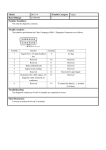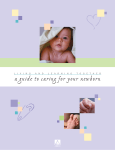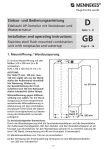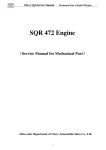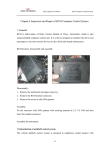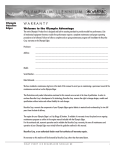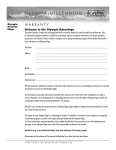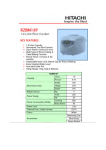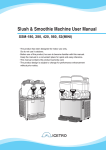Download Chapter two Tests and Adjustments of Four
Transcript
Chery QQ Service Manual Chassis System Chapter two Tests and Adjustments of Four-Wheel Positioning Section One: Basic Tests and Checks Preparations prior to adjustments I. Checks prior to adjustments (1)Checks on tire air pressure (2)Checks on car body 1、Check the tire air pressure, and adjust to the specified pressure. Standard air pressure for tires (kPa) Item Zero load Front wheel 220 Rear wheel 220 Spare tire 250 2、Check the spacing of front wheel bearings, and replace the front wheel bearings when necessary; 3、Check the status of the wheel outer rims, as well as the status of the wheel sections and tires; 4、Check to see if the ball joint of the horizontal draw-bar for turning is too loose; 5、Place the car on a leveled ground without any luggage or passenger; 6、Make sure that the left and right heights from the wheel center line to the dasher do not exceed the standard heights; 7、Check to see if the absorber performance is normal. II. Rim section and tire 1、Visual checks Check the tires and rim sections, and make proper replacements if any cracks, damages, deformations or other defects are detected on the rim sections or tires. Tears and wears of tire - 58 - Chery Automobile Co., Ltd Chery QQ Service Manual Chassis System 2、Tire tears and wears (1)Check the depth of the remaining tire textures. The depth of the remaining tire textures (as shown in the Figure) Standard tires: 1.6mm min. Snow ground tires: 50 % tire textures Wear position (2)In the case that the wear-and-tear indication Wear position belt is exposed, the tire must be replaced. Indication points for tire tears and wears 3、Abnormal tears and wears of tires The abnormal tears and wears of the tires as shown in the right figure might occur. Refer to the following table for the possible causes and the approaches for handling the trouble. bi-wear Center wear Toe-in and toe-out wear Unilateral-wear Tears and wears of tire (a) (b) (c) Possible causes * Insufficient tire air pressure (tears and wears on both sides) * Turning in fast speed * Tire positions not re-adjusted * Excessively high tire air pressure * Tire positions not re-adjusted * Toe-in incorrect * Camber angle incorrect * Suspension system defective (d) * Tires not balanced * Brake drum or disk not circular * Other mechanic troubles * Tire positions not re-adjusted Approaches for handling * Test and adjust tire air pressure * Slow down car speed * Re-adjust tire positions * Test and adjust tire air pressure * Re-adjust tire positions * Adjust the toe-in * Adjust, repair or replace the parts of the axle and suspension system * Repair or replace the suspension system * Make dynamic balance of tires or replace the tire * Make alignment or replacements * Make alignment or replacements * Readjust the tire positions - 59 - Chery Automobile Co., Ltd Chery QQ Service Manual Chassis System 4、Points of attention for the rim sections and tires (1)Do not use the under-standard rim sections or tires; (2)The aluminum alloy rims are easy to be damaged by scraps. Please use soft cloth when doing the cleaning. Never try to use steel brushes. If steam is used for cleaning the car, do not allow the boiling water to contact the rim sections; (3)In the case that some alkali chemical compounds (such as mud water, road surface mud, etc.) stain on the aluminum alloy rim sections, use the neutralizing agents to clean them off as soon as possible so as to avoid the rim sections from being damaged. 5、Tire replacements (1)Before installing the air valve nozzle, first check to see if the air valve opening on the tire is smooth and free of rags. Then apply some glycerin onto the surface of the air valve nozzle rubber or dip the air valve nozzle in the glycerin. Use the special tools to exert the air pressure of 200—400N so as to allow the positioning ring of the air valve nozzle to pass the hole on the wheel which complete the installation and positioning (soap solution can be used to substitute glycerin); (2)Before installing the tires, apply glycerin or soap solution along the tire rings. Make sure that when there are light indication spot marks on the rims, the test marks for tire balance should be aligned with these light indication spot marks. When there are not light indication spot marks on the rim, the dynamic balance test marks of the tire should be aligned with the air valve nozzle position. If there are neither light indication spot marks on the rim nor dynamic balance test marks on the tire, but there are static balance test marks on the tire, make sure that the air valve nozzle is aligned with the static balance test marks. 6、Tire pressure Check the air pressures of all the tires (including the spare tire) with the barometer. Make proper adjustments if the air pressure does not meet the specifications. Strictly follow the specified air pressure in filling the tires with air. During the air filling, the air pressure should not exceed the nominal air pressure by 10 %. The tire with filled air should be placed separate from the wheel mounted on the car. Before doing the positioning of the four wheels, please check the air pressures of the four wheels and make proper adjustments so as to meet the specified air pressure. 7、Air leakage Make sure there is no air leakage at the air valve. Checks of air valve nozzles - 60 - Chery Automobile Co., Ltd tyre air hole Chery QQ Service Manual Chassis System 8、Rim sections and tires non-circularity (1)Lift the car and support it securely; (2)Place the probe of the dial gauge on the rim section and measure the extent of non-circularity for each turning of a circle. Limit for non-circularity: Unit mm Longitudinal 1.5(0.06) Sideways 2.5(0.10) steel rim section 2.0(0.08) aluminum rim section Inspection on the tire non-circularity (3)Replace the tire if necessary 9、Readjustments of tire positions In order to extend the operational life of tires and to determine the tears and wears of the tires, readjustments of tire positions should be carried out for every 6,000km (3,750 miles) of driving. As shown in the Figure: Readjustment of tire positions Attention: * Best-quality tires must be used for the front wheels; * After readjustments of tire positions, make sure that the air pressures for the tires are adjusted to the specified air pressure values. 10、Adjustment of tire balance After the tires are filled with air, fix the protective capsfor the air valve nozzles tightly and then make the testson dynamic balance. Place the balance blocks with appropriate weights on the inner and outer edges of the rims as required. According to the specifications, the imbalance of the final assembly should be no larger than 100g/cm, which is approximately equal to the 5g balance blocks on the inner and outer edges of the rims. It should be noted that at most one balancing block is allowed to be placed on each side of each wheel, with the maximum mass no larger than 70g. During the process of assembling, excessively heavy shocks should be avoided to the balancing blocks. In the case that excessive shocks are felt, the balancing blocks should be replaced in time. The balance blocks taken down in the replacement should not be used again. - 61 - Chery Automobile Co., Ltd Chery QQ Service Manual Chassis System 11、Installation (1) When making the assembly of the outboa wheels and tires, first fix the wheel screws onto block the hubs manually and tighten them slightly. Then use special tools to tighten the screws in the diagonal sequence till the specified torque block of 110±10N.m is applied. It is not allowed to use impact wrenches that might cause damages to the wheels, or insufficient tightness or excessive tightness. It is not allowed to apply lubricating grease onto the wheel screws. (For the completed assembly of wheels and tires, the wheel screws should be re-tightened after the car runs for 100km so that the specified torque is assured. The checks on the torque of the fixing screws are one of the routine maintenance items). (2) When tightening the screw nuts, the cross approach is applied. The extent of tightness should be close to each other, and the wheels should be able to turn freely. When the final tightening is made, the wheels should be positioned on the ground. (3)Install the decorated covers or place the decorative covers as needed. When the clip-type decorative covers are installed, they should be driven in either with hands or by way of rubber hammering tools. III. Checks on the looseness of wheel bearings 1、Check the axial spacing of the bearings Maximum: 0.05mm 2、Check the bias of the bridge hub Maximum: 0.05mm IV. Checks on the looseness of front suspension system V. Checks on the looseness of turning transmission rod system VI. Checks on ball joint looseness VII. Checks on the normal performances of absorbers - 62 - Chery Automobile Co., Ltd Chery QQ Service Manual Chassis System 1、Check to see if there is any oil leakage; 2、Check to see if there are any tears and wears of the assembly sheaths; 3、Check the resistance of the absorbers. Make proper replacement if any incompliance is detected. Section Two: Positioning of Rear Wheels It is recommended to use the four-wheel positioning device for the chassis of this car model, which applies the positioning approach by way of axis thrust. In the position adjustments by way of axis thrust, the toe-in of the rear wheels may have impacts upon the toe-in of the single front wheel. Therefore, when doing the four-wheel positioning, the adjustments of the rear wheels are generally done before the adjustments of the front wheels. Besides, the camber angle of the rear wheels is adjusted before adjusting the toe-in angle, followed by the adjustments of the camber angle and toe-in angle of the front wheels. I. Measure the height of the car Before measuring the height of the car, first increase the air pressure of the tires to the specified value (make sure that the air pressures for the left and right tires should be identical). front 1、The front measuring point The height of the center point from the ground to the link screw nut for the lower control arm assembly and the front turning joints is to be measures. The car body height of the left and right wheels should be basically the same. 2、The rear measuring point The height of the center point from the ground to link screwnut for the rear bridge and the absorber is to be back measured. The left and right body heights should be basically the same. - 63 - Chery Automobile Co., Ltd Chery QQ Service Manual Chassis System Attention: Before testing and checking the wheel positioning, the car should be first adjusted to the specified height. If the car height does not meet the specification, check the front and rear suspension systems of the car to see if there are any damages or deformations. II. Place the wheel positioning device or the positioning tester on the wheel 1、 Install the instruments in the way as specified by the manufacturer of the devices; 2、 Make tests and adjustments on the car as required by the equipment. The specifications for the positioning are as follows: Rear wheel assembly toe-in Single rear wheel toe-in Rear wheel camber angle Thrust angle 201±401 101±201 01±201 -131~+101 Section Three: Front Wheel Positioning I. Measure the car height Do the measuring and adjustments in the same procedures as the ones for the car height measurements for rear wheel positioning. II. Place the wheel positioning device or the positioning tester on the wheel Install the instruments in the way as specified by the manufacturer of the devices. - 64 - Chery Automobile Co., Ltd Chery QQ Service Manual Chassis System III. Check and adjust the front wheel main pin backward tilting angle, main pin interior falling-in angle, wheel camber angle as well as the wheel toe-in and steering angle Specifications: The requirements for the front wheel positioning are as follows: 3°.151±301 [465]:1°±301 Main pin backward tilting angle Front wheel camber angle 101±101 Inner side:350±4° Outer side: 310±4 Single front wheel toe-in angle Steering angle Note: The backward tilting angle is adjusted before adjusting the camber angle and the toe-in angle. 1、Main pin backward tilting angle This angle is assured by way of the designed configuration, which makes the operational adjustments unnecessary. The impacts of backward tilting angle The major function of the backward tilting angle is to keep the car moving in the straightly forward direction. If the backward tilting angle is positive, the inner side of the car will be lowered when the front wheel turns in directions, which results in the uprising of the chassis. That will increase the loads onto the knuckles. If the backward tiling angles of the two wheels are identical, the car will be back to the straightforward direction after turning the directions. The increase of the positive backward tilting angle will increase the stability of the steering wheel, but the turning forces will be increased as well. The decrease of the positive backward tilting angle will reduce the stability of the steering wheel but the turning forces will become reduced. The extent of the backward tiling angles will not have impacts upon the tears and wears of the tires. They are used to stabilize the driving directions and ensure the automatic returning to the straightforward direction after turning. If the car is equipped with the traditional mechanic steering devices, the backward tilting angle will be very small or even tending to be in the negative, which makes the turning of direction easier. If the car is equipped with the dynamic steering device, the backward tiling angle is generally set to be relatively large positive angle, which allows the driver to feel the turning of directions. The increase of the positive backward tiling angle will increase the forces for turning, and increase the stability in straightforward movement of the car. 2、Camber angle Under normal circumstances, the camber angle does not have to be adjusted after the car is equipped with the independent suspension system and wheel knuckles. In the case that the wheel camber angle is detected to have bias from the allowances due to some reasons, - 65 - Chery Automobile Co., Ltd Chery QQ Service Manual Chassis System alignment can be made by way of adjusting the connecting screw nuts for the independent suspension system and the knuckles. (1) First check (visually) to see if there are any damages on the driving system parts and components Adjustment before doing the alignment. Replace the damaged parts or components if there are any. The camber angle of designed and set for the front wheels by the manufacturer screw nut cannot be adjusted; (2) In the case that the front wheel camber angle is detected to exceed the allowed bias, loosen the connecting screw nuts for the front absorber and the knuckles, and move the wheel for proper alignments. 3、Toe-in Special four-wheel positioning testers should be used to test and adjust the toe-in. (1) Make preparations prior to the adjustments as required by the tester. Use the steering wheel limiter to fix the steering wheel in the straightforward direction (the steering wheel must be in the center position±5 degrees, and the lower clamping flange of the steering axle should keep horizontally leveled). (2) Loosen the locking screw nuts (1) of the steering horizontal drawbar. (3) Remove the elastic protective clip ring (2) with a pair of pliers. (1) (2) Attention: Replace the clipping ring if it is not elastic enough. (4) Turn the toe-in adjustment rod to adjust the length as needed till it meets the specified value. (5) Tighten the screw nut (1) and re-install the protective elastic clip ring (2), check to see if the locking screw nut is tight enough and if the position of the protective sheath is correct or not. (6) Upon completion of the adjustments for the front wheel toe-in, check to see if the steering wheel is leveled. If not, loosen the locking screw nut of the steering wheel and adjust the steering wheel to the leveled position. Tighten the locking screw nut till it meets the torque specification (27-33Nm). 4、Check and test the front wheel steering angle After the horizontal drawbar joint is replaced or the toe-in is adjusted, the steering angle should be checked. If it fails to meet the specifications, the length of the left and right horizontal drawbars should be checked and adjusted. - 66 - Chery Automobile Co., Ltd Chery QQ Service Manual Chassis System IV. The toe-in and camber angle of the rear wheels cannot be adjusted. Check the camber angle and toe-in of the rear wheels. If they fail to be in the specified limits, check to see if there are any deformed parts. Replace the defective parts. Section Four: Guide to Trouble-Shooting Problem Possible cause Countermeasures Excessive tear-and-wear As indicated later or unevenly distributed tears and wears of tires Tears and wears of tires Incorrect tire pressure ahead of Adjustment scheduled Incorrect wheel positioning Adjustment operational life Tire noises parameters Incorrect tire air pressure Adjustment Tears and wears of tire Check, adjustment, replacement Insufficient tire pressure Adjustment Imbalance of tires Adjustment Deformed rim section or tire Repair or replacement Road surface noises or vibration of car body Unevenly distributed tears Check, and wears of tire - 67 - Chery Automobile Co., Ltd replacement adjustment, Chery QQ Service Manual Vibration up and down of steering wheel Circling vibration of steering wheel Lopsidedness of steering wheel Unstable movement Lopsided braking Heavy steering wheel Poor operation of steering wheel to return to straight forward direction Chassis System Excessive bias of tire and rim section Loose wheel screw nuts or axle heads Imbalance of tires Broken or damaged engine suspension rubber Broken or damaged gear box supporting stand rubber Excessive bias of tire and rim section Loose wheel screw nuts or axle heads Imbalance of tires Unevenly distributed tears and wears of tire Insufficient tire air pressure Broken or damaged front wheel bearings Faulty steering system Faulty suspension system Abnormal tire air pressure Excessive tears and wears of tires or unevenly distributed tears and wears Faulty steering system Faulty braking system Faulty suspension system Inconsistent air pressures for the tires on both sides Deformed rim section or tire Loose wheel screw nuts Faulty steering system Faulty suspension system Unbalanced tire air pressures on both sides Faulty braking system Insufficient tire air pressure Faulty steering system Faulty suspension system Incorrect wheel positioning parameters Insufficient tire air pressure Faulty steering system Faulty suspension system Incorrect front wheel main pin backward tilting - 68 - Chery Automobile Co., Ltd Replacement Tightening Adjustment Replacement Replacement Replacement Tightening Adjustment Check Adjustment Replacement Check Check Adjustment Check Check Check Check Adjustment Repair or replacement Tightening Check Check Adjustment Check Adjustment Check Check Check Adjustment Check Check Adjustment











